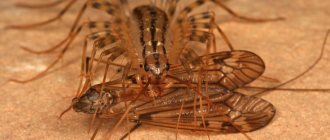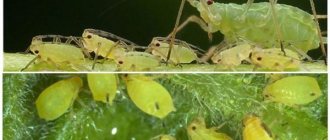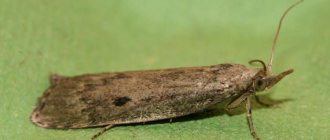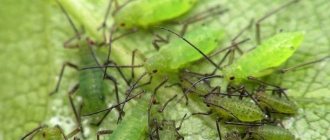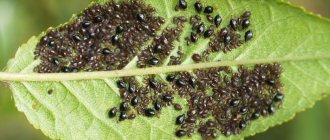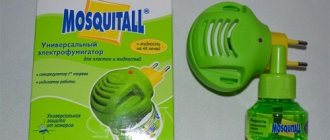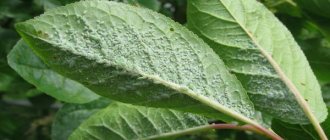Aphids are small sucking pests.
The invasion of green midges is detrimental to young tomatoes. Ignoring the first signs of the appearance of insects and untimely destruction of them will lead to the complete loss of seedlings.
This article will tell you how to recognize aphids, how to fight them, and what preventive measures to take to prevent a new appearance.
What it is?
Aphids are tiny, soft-bodied insects. The body is pear-shaped and reaches a length of 0.5-1.0 mm. Depending on age, individuals can be winged or wingless. Pests love to feast on young tomato leaves: they contain a large amount of juice and a low proportion of coarse fiber.
Aphids are able to camouflage themselves into their environment. The plant pigment, along with the juice, enters the insect’s body, and the body turns a different color, most often pale green.
The life cycle of aphids occurs as follows:
- In autumn, winged fertilized females lay eggs on wild radish, rapeseed, and cabbage stalks. The embryos survive the winter safely.
- In warm spring, larvae appear. They begin to eat young shoots.
- After molting, the process of asexual reproduction begins. The result of this stage is the appearance of wingless females. They provide new growth to the colony through the birth of new larvae.
- Around mid-summer, winged individuals appear. Here, a small part of the pests begin to experience a significant lack of food, which leads to their death. There is a strong increase in new colonies.
- At the end of summer, winged representatives of different sexes appear. At this stage, mating occurs. Females lay eggs. Colonies die. The cycle repeats.
Reference! Scientists have proven that in just 30 days of asexual reproduction, one female is capable of producing 2-3 generations of small individuals. The brood size exceeds 10 thousand.
Signs of aphids are curled leaves, greens and shoots covered with sticky sweet secretions. It is clear that the invasion of unpleasant pests does not benefit young tomatoes.
Recipe based on tomato leaves
As noted, tomatoes, as members of the nightshade family, contain toxic compounds called alkaloids in the fruit and leaves. When tomato leaves are crushed, they release these substances, which when diluted with water become even more toxic to insects. In addition, the liquid form of the solution allows for more effective spraying treatment.
To prepare this solution, you simply need to soak one to two cups of chopped tomato leaves in two cups of water. If possible, you can chop ripe fruits there, but you should not use tomatoes bought in the store for these purposes - they must be fresh. The mixture is infused for 24 hours. After this, the “porridge” needs to be strained through cheesecloth and added 300-500 ml of water.
White and other types of pests living on tomatoes
The most common representatives found on tomatoes are:
- White or root aphids. Appears from eggs overwintering in the ground. Individuals are difficult to detect. They move quickly and gradually chew through the base of the stems. Pests completely block the access of moisture to the root system of seedlings. The result is that young bushes stop developing.
- Potato. Has a red or green tint to the body. Reaches a length of up to 4 mm. It feeds on leaves and stems.
- Bakhcheva. A small pest measuring 1-2 mm. Color – all shades of green. The larvae become active in early summer. In July-August they fly out into the open air, and the winged females are black and green in color. They feed on tomatoes and other garden crops.
- Peach or greenhouse. Overwinters at the bases of peach tree buds. After awakening, he successfully moves to tomatoes.
The appearance of aphids on seedlings cannot be ignored. After planting the plants in greenhouses or open ground, the individuals will find themselves in a favorable environment. They will begin to multiply, thereby destroying many species of garden plants. Even worse, they will move to neighboring areas and begin to devour everything in their path.
Mistakes of beginner gardeners
Inexperienced gardeners often do not pay attention to signals that there are aphids in the area, and therefore precious time for a quick response is lost, and the pests make their home in the garden.
Signs that precede an aphid invasion:
- Ant activity. Ants are friends of aphids, so if you notice the movement of ants in the beds, it means that aphids will soon appear on the seedlings. What to do? Fight ants.
- Several pests on the branches. This is a signal that they will attract hordes of aphids in a short period of time. Immediately start spraying the plants with what you have at hand: soap solution or ash.
- Rarely weeding the beds. Frequent loosening of the soil is the key to good air circulation between tomato bushes, which is beneficial for plant health. If you grow crops in greenhouses, do not forget to ventilate them more often.
Inspection of plants should be done several times a week, looking under the leaves of the plantings, because this is a favorite breeding place for aphids. The faster you react and apply one of the methods described above, the more effective the measures to destroy aphids will be.
What infected plants look like: description and photo
Curled leaves, deformed shoot tips, sweet discharge (also called honeydew) are damage that can be detected the day after the aphid appears.
Honeydew causes the development of sooty fungus (another name for this fungus is niello). It is almost impossible to cure tomatoes from cellulite. Sooty fungus disrupts plant photosynthesis and clogs pores. Tomatoes weaken, wither, and die.
Attention! Ants are another sign of aphids on tomatoes. As practice shows, where there is a small pest there is a horde of ants. Industrious insects are attracted to secretions on leaves and shoots.
The symbiosis of ants and aphids is an interesting phenomenon (if we ignore the fact of parasitism). Some ants protect and “bring up” small green individuals in order to receive honeydew in return.
What insects will help get rid of aphids?
Her natural enemies, of which there are many, will help get rid of aphids: earwigs, hoverflies, lacewings, wasps and especially ladybird larvae. These insects need to be attracted in every possible way to those areas where tomatoes are planted. This must be done before the plants are planted in the beds, since beneficial insects must have time to reproduce. Biomaterial can be purchased at vegetable growing stores.
We recommend reading
Rules for feeding tomatoes with ash
How to deal with common tomato diseases
Measures to combat late blight on tomatoes and what can be treated with them
How to properly feed tomatoes with iodine
Reasons for appearance
Important! Tomatoes are grown using seeds or purchased ready-made seedlings. In the first case, aphids can hide in the ground and become active in a favorable environment. In the second case, individuals may already be on the back side of the leaves.
When purchasing young plants, it is important to carefully examine the leaf blade.
Favorable conditions for the development and reproduction of the pest are as follows:
- a warm, dry room without drafts, but well ventilated;
- temperature from +25 to +30°C.
Aphids in stuffy and warm rooms can move to indoor flowers and other garden seedlings. Often individuals were spotted on verandas and balconies. They ate almost all ornamental plants.
Symptoms
Novice gardeners may not recognize aphid damage in tomato beds in time. The pest consumes sap from the top of the shoots, weakens them, resulting in greatly reduced growth. Tomatoes wither and yield decreases. By carefully inspecting garden crops, you can notice warning signs of pest infestation:
- clusters of small black and white dots are visible on the stems and leaves;
- droplets of sweet liquid appear on the leaf blades;
- seedling growth slows down, some leaves become deformed or look limp.
A sooty fungus often develops on the sticky secretions of aphids - a black coating appears. It can be easily removed with a damp sponge. Small lesions merge into solid dark spots. Having noticed signs of infestation, it is important to know how to treat aphids on tomatoes at home.
How to fight?
What to do if the plant is attacked by insects: fight with chemical and biological preparations. They help get rid of colonies in a short time. The active substances penetrate through the oral apparatus into the intestines and torso. But not every person will decide to treat plants with pesticides, because these substances will remain in the plants.
Folk remedies are safe but ineffective methods. They can only repel insects, not destroy them. The result is that the aphids move to neighboring vegetable crops and continue to reproduce safely. But first things first.
Answers to frequently asked questions about aphids
Question No. 1. What harm does aphid do to tomatoes?
Insects attack the vegetative part of the plant, in particular the leaves. They do not touch the fruits, but the crop itself weakens, its immunity decreases, so it does not have enough strength to ripen the fruits. Tomatoes deteriorate and become deformed. The harvest is unfit for consumption. Aphids also leave depressions in the leaves into which other pests colonize.
Question No. 2. Why do aphids appear?
Question No. 3. Which tomato varieties are resistant to the pest?
The varieties Bobcat, Belfast, Cherry, Salting Miracle, Dalnevostochnye, and Apollo are resistant to aphids.
If the pests have not multiplied greatly, then mild insecticides are used, because spraying alone is not enough, and with prolonged use, powerful chemicals will saturate the soil and fruits. Potent drugs are used if the aphids have multiplied greatly. Aktara will do.
Question No. 5. How to properly spray tomatoes in a greenhouse?
As in open ground, in the greenhouse the leaves are sprayed from the bottom. It is in that place that aphids parasitize. For spraying you will need a sprayer with a flexible hose; a mini sprayer will not work. When using chemicals, spray three times every six days; if using biological products, for example Fitoverma, then two sprays are carried out with an interval of 2 days. Further processed as necessary.
How to treat it at home?
Use of chemicals
Attention! Insecticides are considered the best pesticides. They fight well against adults, larvae and eggs.
The drugs are divided into several groups:
- contact – act on the entire body of insects;
- intestinal – cause poisoning during food intake;
- systemic - the insect dies after the poison enters the body;
- fumigants - penetrate the respiratory tract, causing poisoning.
Here are several effective preparations that can be sprayed on plants and which have positive reviews:
- Confidor. Systemic insecticide with enteric contact action. Suitable for treating greenhouse and outdoor plants. The drug is diluted in water: 1 g/10 l. Plants are sprayed with a spray bottle. Results are noticeable within 2-3 hours. It is recommended to spray tomatoes throughout the entire growing season, except for the stage of inflorescence development. The approximate cost is from 30 to 70 rubles.
- Fufan or Fufanon. Belongs to hazard class 3, affects the pest through the intestines. Suitable for processing in greenhouses and open ground. The drug is diluted in water: 2 ml/1.5 l. The plants are sprayed with the prepared solution. 2-3 treatments with an interval of 1 week are enough. The approximate price is from 19 to 100 rubles.
- Spark. Excellent for treating adult plants and seedlings. Shows intestinal contact action. Available in tablets. The solution is prepared at the rate of 1 tablet per 1 liter of water. Afterwards, the mixture is filtered, supplemented with clean water to 5 liters, and the plants are sprayed. Reapply after 3 weeks. The approximate cost is from 12 to 150 rubles.
Use medications strictly according to instructions. Failure to follow the manufacturer's recommendations will lead to undesirable consequences. Process tomatoes only with gloves, a mask and special clothing. After finishing work, wash your hands with laundry soap. Tomatoes in open areas are processed again in the morning if it rained at night.
Biological drugs
The active ingredients of this group are environmentally friendly living bacteria or their metabolic products. They are not dangerous to humans or the environment. Anti-aphid drugs are new and not so popular. Here are several types:
- Fitoverm. The basis is aversectin C. This is a substance produced by bacteria. Preparation of the solution: dilute 3 ml of the drug in 10 liters of water. Spray plants in the evening in warm, dry weather, but not before rain. 3 hours after processing the tomatoes, the insects stop feeding, and after 3-6 days they die. Repeated processing is performed if new individuals are present.
- Akarin. The composition and mechanism of action are similar to the previous drug. The substance in an amount of 80 ml is diluted in 10 liters of water. Spray the tomatoes using a fine-hole sprayer. The aphid dies after 2 days.
- Bitoxibacillin. Insects are killed by living bacteria Bacillus thuringiensis. Dilute 5-7 ml of the drug in 10 liters of water and spray the tomatoes with the prepared solution.
Important! Be sure to use biological products strictly according to the instructions. Re-process tomatoes after 8 days 2 or 3 times. Vegetables can be eaten only 4-5 days after harvest.
Folk remedies
Here are some effective recipes:
- Garlic. The large head is crushed and 1 liter of boiling water is poured. After cooling, add 2 teaspoons of any detergent or laundry soap, 2 tbsp. spoons of vegetable oil. The finished liquid is poured into a spray bottle and each bush is thoroughly sprayed.
- From the ashes. Stir 1 cup of wood ash in 5 liters of water. Leave to brew for 12 hours. Then this mixture is sprayed on the affected greens.
- Soap and soda. Grind 1/4 of a soap bar. Soap powder is mixed with 1 tbsp. spoon of soda in 1 liter of warm water. If you don’t have a sprayer at hand, you can replace it with a watering can with a shower head. Tomatoes are watered from above.
- Ammonia. Recipe: 2 tbsp. spoons of ammonia and 1 tbsp. a spoonful of soap is diluted in a bucket of water. The liquid is poured into a plastic container. Place a spray bottle on the bottle and spray the plants. People note the high effectiveness of this old method.
It will not be possible to destroy all individuals. Folk recipes will scare away aphids, and they will move to neighboring plants. It is better to treat the entire garden, including flowers, with the mixture.
What insects will help get rid of the pest?
Ladybugs, lacewings, sand wasps, earwigs, crickets, ground beetles, and spiders readily feed on small green pests.
Plants that repel insects
Rosemary, oregano, mint, nettle, alfalfa, fava beans, clover, sweet clover, buckwheat, rye, mustard. They repel insects with their pungent smell and taste.
Chemicals
It is best to combat aphids with chemicals before the onset of the tomato flowering period, so that harmful substances do not enter the fruits. To do this, you can use various drugs against aphids and other pests:
- Biotlin is a drug that is recommended for use in greenhouses; it destroys adult pests and inhibits the development of aphid larvae. The solution is prepared by adding 5 ml of product per bucket, which will allow you to spray tomatoes over an area of up to 30 square meters. m.
- Spark is an insecticide that will help not only poison aphids and other types of insects, but also feed plants with potassium supplements and anti-stress additives.
- Karbofos is an effective remedy for aphids, it penetrates the insect body through the shell, maintaining a toxic effect for 7-10 days, and has low toxicity for humans.
- Aktara, Tanrek - poison aphids after they eat the green parts of treated plants; treatment of tomatoes against aphids is carried out according to the instructions in a certain dosage; it should be taken into account that the substance can accumulate in the fruits.
- Biological product Fitoverm, which has a wide spectrum of action.
- Chloride of lime - used for spraying the lower part of leaves and stems, has a positive effect on the soil and helps in the fight against not only aphids and other pests, but also diseases of garden crops.
Important!
It is necessary to treat and spray tomatoes against aphids 3 times with a one-week break, since it is during this time that the next generation of pests matures.
Chemicals for killing insects
Prevention of occurrence
In order not to look for effective methods of controlling aphids in spring and summer, it is enough to carry out preventive procedures in the fall. Be sure to burn the tops after harvesting. Work the ash into the soil, then dig it up. Whiten the trunks of trees and shrubs.
During the growing season of tomatoes, remove fallen leaves. In the fall, destroy all dead wood on the site. Loosen the soil near the stems in a timely manner. Reduce the number of anthills. Caring and attentive attitude towards your garden is the best prevention.
Simple recipes and modern effective preparations are the best protectors of tomatoes. Which method of controlling aphids to choose depends on the personal preferences of the gardener. Only timely detection and destruction of small individuals will allow preserving the plants and reaping a rich and tasty harvest of tomatoes.
Reviews
Antonina Dmitrievna
City - Vologda
For me, aphids are a scourge. She's everywhere. Trees, bushes, roses and now tomatoes. We recommended Biotlin. I bought it because it wasn't expensive. Very satisfied, effective product. But, strangely, she still appeared. It turns out that you have to treat it 3-4 times per season; it’s a very dangerous pest.
Sergey
City — Smolensk region
I don’t understand why aphids are such a problem. It can be easily removed with a solution of laundry soap. The main thing in this matter is the multiplicity. For example, I spray everything at once every 1st and 20th. I made the solution, filled the sprayer, walked along the young shoots of the vegetable garden, and there were no problems. I recommend to everyone.
Vasily Pavlovich
Yekaterinburg city
For a long time I could not solve the problem with aphids in the greenhouse. Then I decided to leave it empty for one year, but to my surprise it did not solve the problem. I used the drug Bitlin from August. A good remedy, it helped, but by the fall it needed to be processed again, and the crop was already turning red. I had to use home remedies. I tried a lot, but simple soap was enough. I plan it and fill it with water by eye, so that the foam is stable. I process it several times, but there are much fewer insects.
Sonya
Samara city
I am a supporter of organic farming. In the fight against aphids, Fitoverm is the most effective and reliable drug. Non-toxic and natural. I spray it all over my garden, garden, and flower garden. I often run around with a spray bottle, but the insects have forgotten their way to me. I highly recommend it, especially for those who cannot tolerate chemicals.
